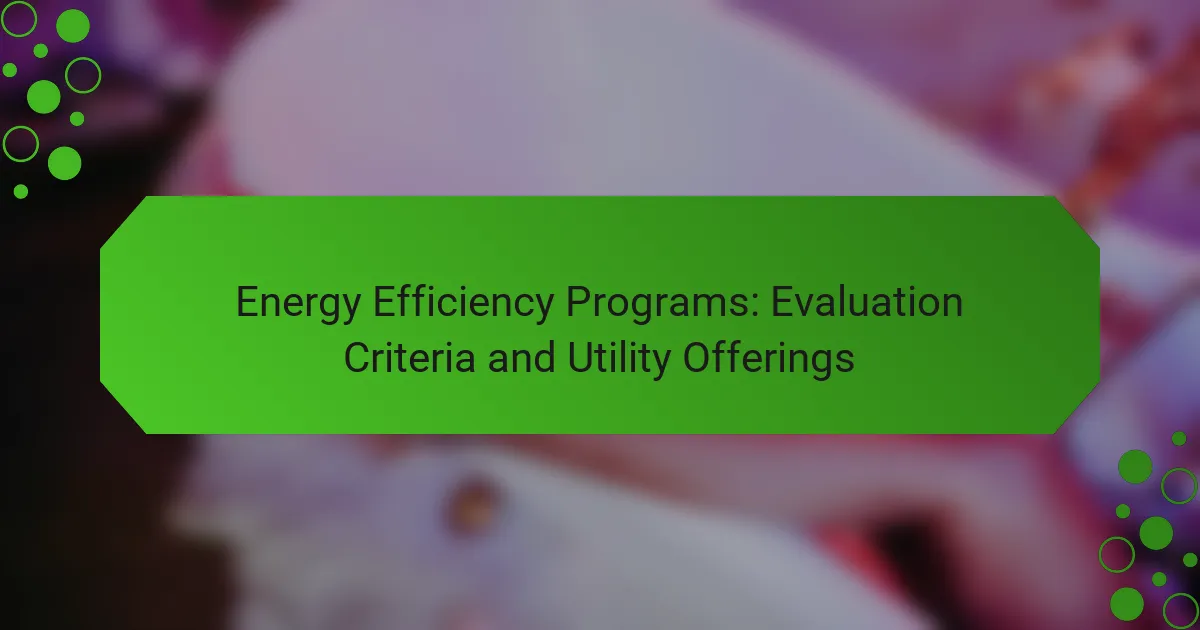Energy efficiency programs offered by utilities play a crucial role in helping consumers reduce their energy consumption and lower their utility bills through various incentives and services. Evaluating these programs involves examining their effectiveness, cost, and participant feedback, with key criteria including cost-benefit analysis and sustainability. Understanding regulatory compliance and the target audience’s needs is essential for selecting programs that are both effective and financially viable.
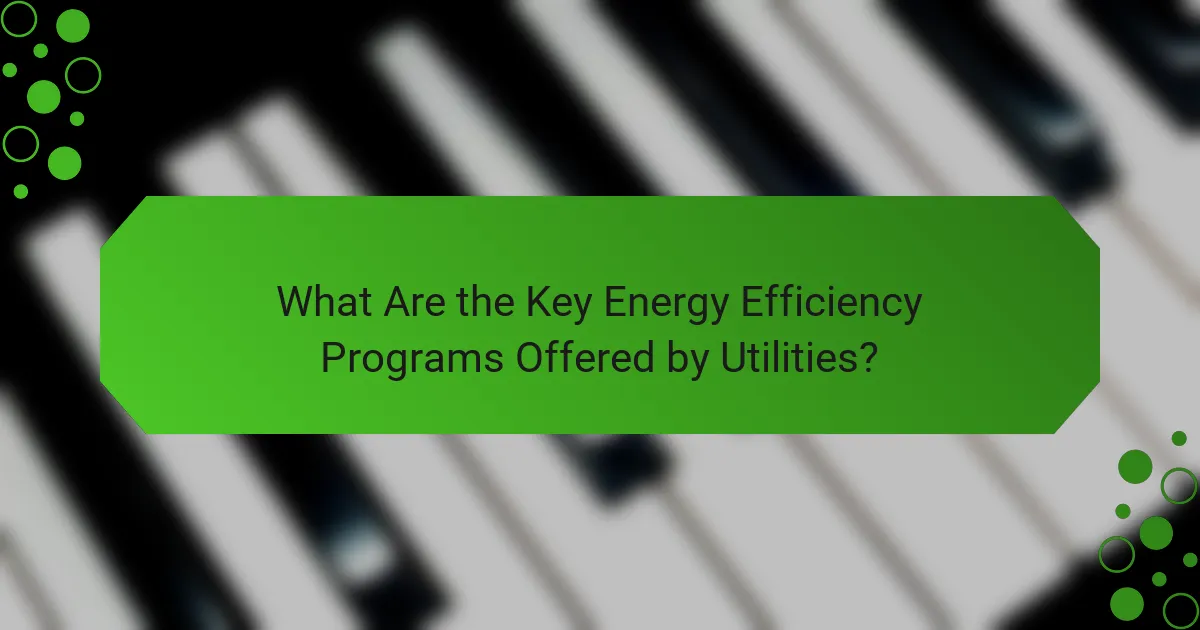
What Are the Key Energy Efficiency Programs Offered by Utilities?
Utilities provide various energy efficiency programs designed to help consumers reduce energy consumption and lower utility bills. These programs often include incentives, rebates, and services that promote energy-saving practices and technologies.
Demand Response Programs
Demand response programs incentivize consumers to reduce their energy usage during peak demand periods. Participants may receive financial rewards or bill credits for lowering their electricity consumption when requested by the utility.
These programs can help stabilize the grid and prevent blackouts, making them beneficial for both consumers and utilities. To participate, customers typically need to enroll and may require smart meters or other technology to monitor usage.
Rebates for Energy-Efficient Appliances
Utilities often offer rebates for purchasing energy-efficient appliances, such as refrigerators, washing machines, and HVAC systems. These rebates can significantly reduce the upfront cost of these appliances, encouraging consumers to choose more efficient models.
Rebate amounts vary by program and appliance type, but they can range from a few dozen to several hundred dollars. It’s essential to check eligibility requirements and application processes to ensure you receive the rebate.
Home Energy Audits
Home energy audits assess a household’s energy use and identify opportunities for improvement. Utilities may offer free or discounted audits, which can help homeowners understand where they can save energy and money.
During an audit, professionals evaluate insulation, heating and cooling systems, and appliance efficiency. Homeowners receive a report with recommendations, which may include upgrades or behavioral changes to enhance energy efficiency.
Weatherization Assistance Programs
Weatherization assistance programs help low-income households improve their energy efficiency through services like insulation, air sealing, and heating system upgrades. These programs aim to reduce energy costs and enhance comfort in homes.
Eligibility typically depends on income levels, and services are often provided at no cost to qualifying households. Participating in these programs can lead to substantial savings on energy bills and improved living conditions.
Renewable Energy Incentives
Utilities may offer incentives for installing renewable energy systems, such as solar panels or wind turbines. These incentives can include rebates, tax credits, or performance-based payments, making renewable energy more accessible to consumers.
Incentive programs vary by region and can significantly offset installation costs. Homeowners should research local offerings and consider long-term savings on energy bills when evaluating renewable energy options.
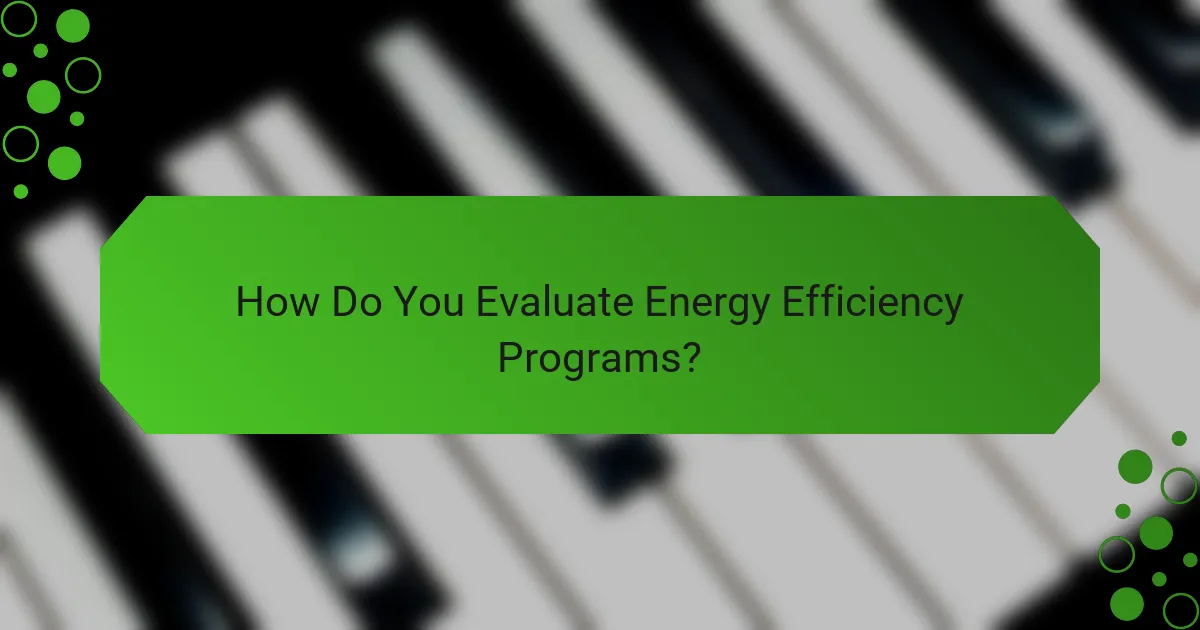
How Do You Evaluate Energy Efficiency Programs?
Evaluating energy efficiency programs involves assessing their effectiveness, cost, and participant feedback. Key criteria include cost-benefit analysis, energy savings potential, participant satisfaction, and the program’s sustainability over time.
Cost-Benefit Analysis
A cost-benefit analysis compares the total costs of implementing an energy efficiency program against the expected savings. This evaluation helps determine whether the financial investment is justified by the anticipated reduction in energy expenses.
When conducting this analysis, consider both direct costs, such as installation and maintenance, and indirect costs, like potential disruptions during implementation. A common heuristic is to aim for a benefit-to-cost ratio of at least 1.0, meaning that for every dollar spent, at least one dollar in savings is generated.
Energy Savings Potential
Energy savings potential refers to the estimated reduction in energy consumption resulting from the program. This metric is crucial for understanding the program’s impact on overall energy use and greenhouse gas emissions.
To evaluate this potential, analyze historical data from similar programs and consider factors such as the type of technology used and the target audience. Programs that achieve savings of 10-30% are often considered successful, depending on the baseline energy consumption.
Participant Satisfaction Surveys
Participant satisfaction surveys gauge the experiences and perceptions of those involved in the energy efficiency program. High satisfaction levels can indicate effective communication, support, and overall program design.
When designing surveys, focus on key areas such as ease of participation, perceived value, and the likelihood of recommending the program to others. Aim for a response rate of at least 20-30% to ensure representative feedback, and analyze the results to identify areas for improvement.
Program Longevity and Sustainability
Program longevity and sustainability assess whether an energy efficiency initiative can maintain its benefits over time. A sustainable program continues to deliver energy savings and participant engagement well beyond its initial implementation phase.
Consider factors such as ongoing funding, regulatory support, and community involvement when evaluating sustainability. Programs that incorporate continuous improvement practices and adapt to changing technologies tend to have better longevity and effectiveness.
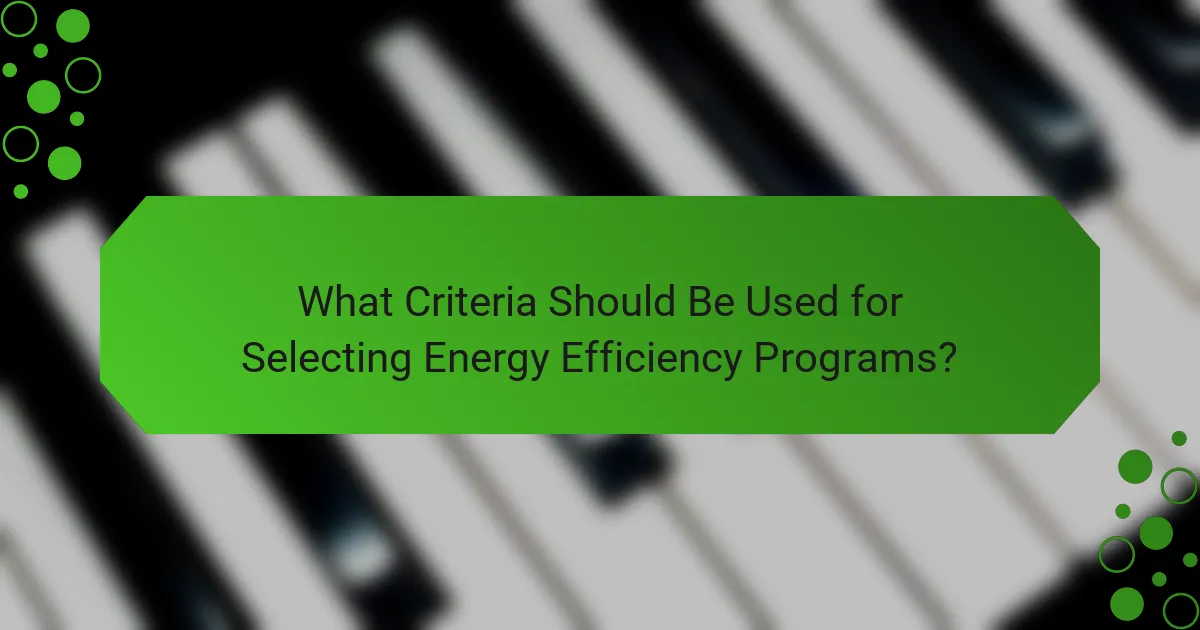
What Criteria Should Be Used for Selecting Energy Efficiency Programs?
When selecting energy efficiency programs, key criteria include regulatory compliance, understanding the target audience’s needs, and identifying available funding sources. These factors ensure that programs are effective, relevant, and financially viable.
Regulatory Compliance
Regulatory compliance is essential for energy efficiency programs as it ensures adherence to local, state, and federal laws. Programs must align with regulations such as the Energy Policy Act or specific state mandates aimed at reducing energy consumption.
To evaluate compliance, review relevant guidelines and standards that apply to your region. For instance, programs in the European Union must comply with the EU Energy Efficiency Directive, which sets specific targets and reporting requirements.
Target Audience Needs
Understanding the needs of the target audience is crucial for the success of energy efficiency programs. This involves assessing the demographics, energy usage patterns, and specific challenges faced by the community or sector being served.
Conduct surveys or focus groups to gather insights on what incentives or support would motivate participation. For example, residential programs may need to address concerns about upfront costs, while commercial programs might focus on long-term savings and operational efficiency.
Available Funding Sources
Identifying available funding sources is vital for implementing energy efficiency programs. Funding can come from government grants, utility incentives, or private investments, each with its own application process and eligibility criteria.
Explore local, state, and federal funding opportunities, as well as partnerships with utility companies that often provide financial support for energy-saving initiatives. For example, the U.S. Department of Energy offers various grants that can help offset program costs, making them more accessible to participants.

How Do Energy Efficiency Programs Impact Utility Bills?
Energy efficiency programs can significantly lower utility bills by reducing the amount of energy consumed in homes and businesses. These programs often provide incentives for upgrades and improvements that lead to lower monthly energy costs.
Reduction in Monthly Energy Costs
By participating in energy efficiency programs, consumers can see a direct reduction in their monthly energy bills. For instance, implementing energy-efficient appliances or insulation can lead to savings of 10-30% on electricity costs. Utilities often offer rebates or discounts for these upgrades, further enhancing financial benefits.
It’s essential to evaluate the upfront costs versus the long-term savings when considering these improvements. Homeowners should look for programs that provide clear guidelines on potential savings and available incentives to maximize their investment.
Long-Term Savings Projections
Long-term savings from energy efficiency programs can be substantial, often exceeding initial investment costs over time. Many studies suggest that energy-efficient upgrades can yield savings that accumulate to thousands of dollars over 10-20 years. This is particularly relevant in regions with high energy prices.
When planning for long-term savings, consider the lifespan of the upgrades and the local utility rates. Regularly reviewing energy bills and tracking savings can help homeowners understand the financial impact of their efficiency investments. Additionally, staying informed about evolving programs and incentives can maximize these benefits.
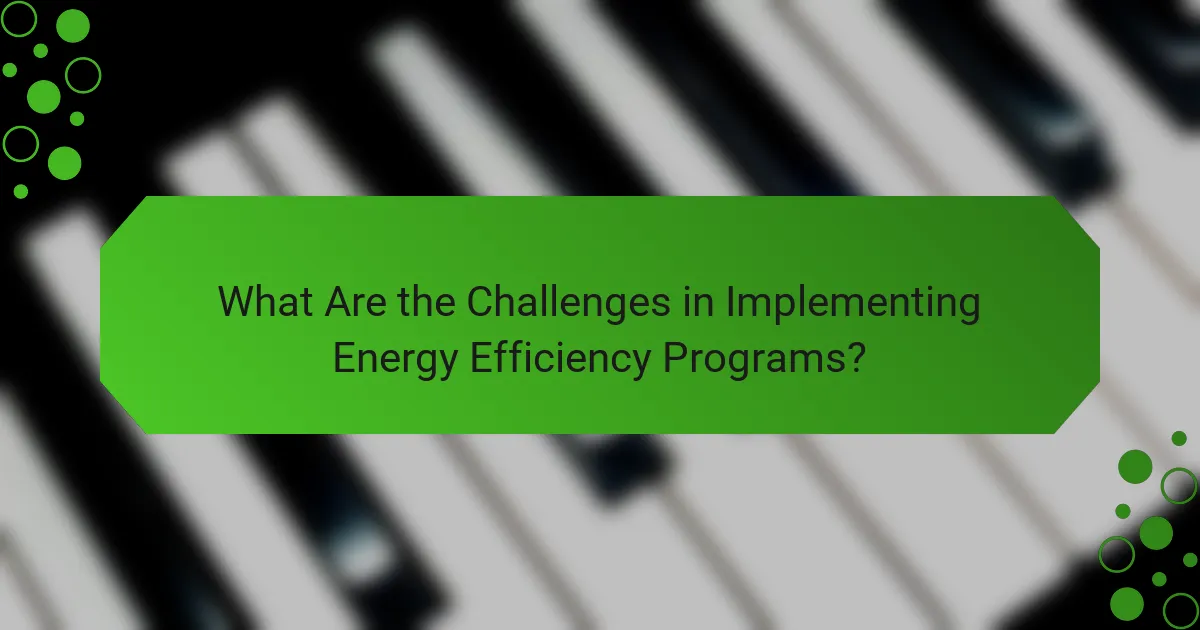
What Are the Challenges in Implementing Energy Efficiency Programs?
Implementing energy efficiency programs often faces several challenges that can hinder their effectiveness and adoption. Key obstacles include funding limitations, consumer awareness and engagement, and technological barriers that can complicate program execution.
Funding Limitations
Funding limitations are a significant challenge for energy efficiency programs, as they often rely on government grants, utility incentives, or private investments. Many programs struggle to secure adequate financial resources, which can lead to reduced scope or even cancellation.
Utilities may face budget constraints that limit their ability to offer incentives for energy-efficient technologies. This can result in fewer options for consumers and businesses looking to invest in energy-saving solutions.
Consumer Awareness and Engagement
Consumer awareness and engagement are crucial for the success of energy efficiency programs. Many potential participants are unaware of the benefits or available incentives, which can lead to low enrollment rates.
Effective outreach strategies, such as community workshops and targeted marketing campaigns, can help increase awareness. Utilities should focus on educating consumers about the long-term savings and environmental benefits of energy efficiency measures.
Technological Barriers
Technological barriers can impede the implementation of energy efficiency programs. Some consumers may lack access to the latest technologies or may be hesitant to adopt new solutions due to perceived complexity or cost.
Utilities and program administrators should consider providing technical assistance and resources to help consumers navigate the options available. Offering demonstrations or pilot programs can also encourage adoption by showcasing the effectiveness of energy-efficient technologies.
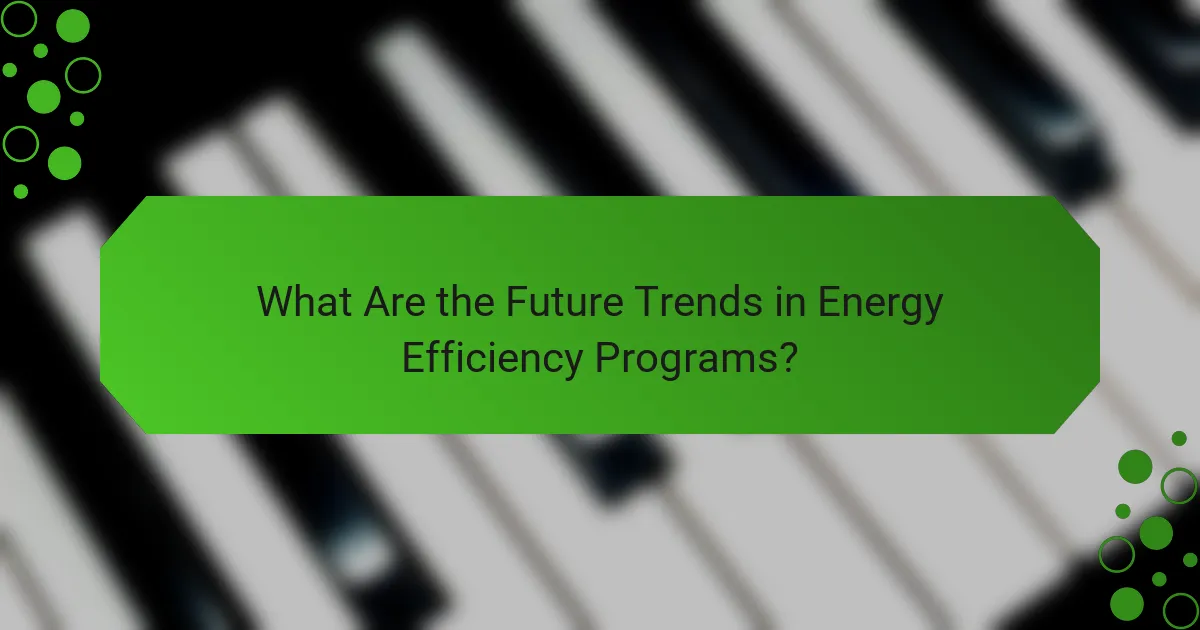
What Are the Future Trends in Energy Efficiency Programs?
Future trends in energy efficiency programs focus on integrating advanced technologies, enhancing consumer engagement, and prioritizing sustainability. As utilities and governments adapt to changing energy landscapes, these programs will increasingly leverage data analytics and smart technologies to optimize energy use.
Integration of Smart Technologies
The integration of smart technologies, such as smart meters and IoT devices, is transforming energy efficiency programs. These tools provide real-time data on energy consumption, allowing users to make informed decisions about their energy use. For example, smart thermostats can automatically adjust heating and cooling based on occupancy patterns, leading to significant energy savings.
Utilities are increasingly adopting these technologies to enhance program effectiveness. By offering incentives for smart device installations, they can encourage consumers to participate in energy-saving initiatives. This trend not only improves energy efficiency but also fosters a more interactive relationship between consumers and energy providers.
Consumer Engagement and Education
Enhancing consumer engagement is crucial for the success of energy efficiency programs. Utilities are focusing on educational campaigns that inform customers about the benefits of energy-saving measures. These initiatives often include workshops, online resources, and personalized energy reports that highlight potential savings.
Effective communication strategies can significantly boost participation rates. For instance, providing clear information on how to access rebates or incentives can motivate consumers to take action. Additionally, using social media platforms to share success stories can inspire others to join energy efficiency efforts.
Sustainability and Environmental Impact
As sustainability becomes a priority, energy efficiency programs are increasingly aligned with environmental goals. Programs are now designed to reduce carbon footprints and promote renewable energy sources. For example, initiatives that encourage the use of energy-efficient appliances contribute to lower greenhouse gas emissions.
Utilities are also exploring partnerships with environmental organizations to enhance program credibility and reach. By emphasizing the environmental benefits of energy efficiency, these programs can attract a broader audience and foster a culture of sustainability within communities.
